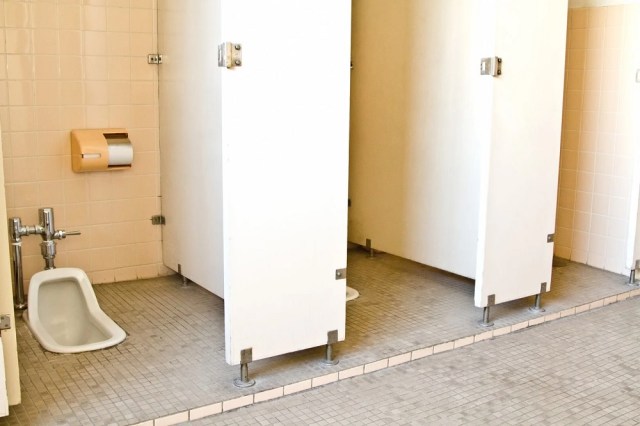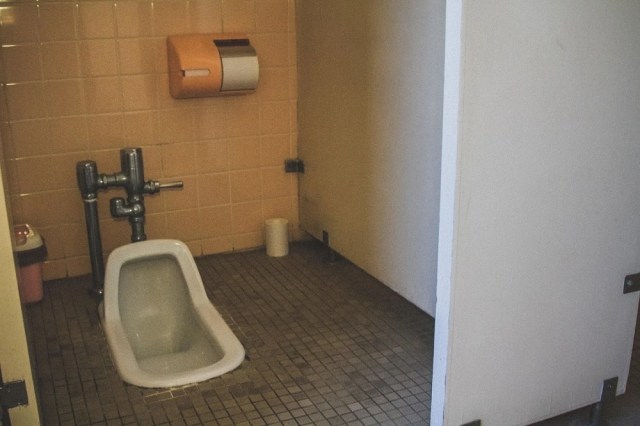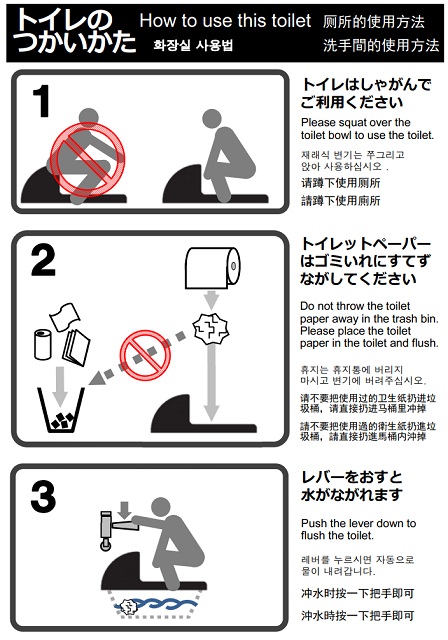
Public restroom trash containers overflowing with used wiping papers also a problem.
This summer was the first since Japan fully reopened to international tourism. That resulted in a big spike in visitors from abroad coming to the country to experience Japanese culture, enjoy Japanese food…and be confused by Japanese toilets.
Miyama Kayabuki no Sato is a village in Kyoto Prefecture, to the north of Kyoto City, with a collection of preserved traditional farmhouses and a museum detailing how daily life was for past generations who lived in this bucolic community. Kayabuki no Sato, which is part of Natan City, welcomes visitors from overseas, but in recent months they’ve been having problems with how some of those visitors are using one of the town’s public restrooms, which is located near the parking lot for tour busses. Yoshifumi Nakano, head of the Kayabuki no Sato Preservation Society, thinks that the trouble stems from overseas visitors being unfamiliar with multiple aspects of how Japanese-style toilets are meant to be used, leading to poo on the floor and overflowing trash containers.
Out of the 12 restroom stalls at this restroom, eight of them have Japanese-style toilets, similar in design to the one shown in the photo above. For some visitors coming from countries that have no squat-style toilets, their natural tendency may be to use the Japanese-style toilet in as close a manner as they can to a Western-style one: they step into the stall, close the door, then do their business while facing the front door, and with their hindquarters facing towards the toilet, with some apparently even lightly resting their buttocks on the tip of the raised half-dome like it’s a toilet seat.
This is, though, the opposite of how you’re supposed to situate yourself. Having your butt hovering near the dome increases the chance that your droppings will drop onto the top of the dome, from where it’ll slide down to the bathroom floor. To help prevent this, the proper way to took a dump in a Japanese-style toilet it to face the toilet itself, scooching up close to the dome and also using it as a guide to make sure you’ve got your anus laterally lined up so that your deposits will land in the bowl and can be flushed away.
Inaccurate deuce-dropping isn’t the only problem Kayabuki no Sato is grappling with these days, though. Nakano says that the trash containers inside the village’s restrooms stalls are sometimes overflowing with feces-streaked paper after international tour buses come through.
As seen in the example photo above, many Japanese bathrooms have a small lidded trash container located inside the stall and within arm’s reach of the toilet. For visitors from countries where the sewage system doesn’t have the capacity for paper and wet wipes to flow through the pipes, this container might look like where you’re supposed to stick your paper after you wipe your butt, as is the case in many parts of southeast Asia.
However, in Japan that’s not what these containers are there for. The Japanese sewage system has no trouble flowing toilet paper, and these in-stall trash containers are primarily meant as receptacles for used feminine hygiene products. That’s why you typically only see these trash containers in women’s or mixed-use stalls, and also why the containers aren’t very big. With overseas visitors to Kayabuki no Sato putting used wiping paper in there, though, that’s a much larger volume of trash, to the point where Nakano says that the parking lot administrative staff has had to start emptying the containers because they’re filling up and overflowing by the time of the cleaning staff’s next pass through the restrooms.
None of this should be taken to mean that Kayabuki no Sato doesn’t want foreign visitors. Still, poo staining the floor and spilling out of wastebaskets is a problem, especially for a country that prides itself on cleanliness as much as Japan does. The three other public restrooms in the village have already been converted to all-Western-style toilets, and Nakano says the plan is to convert the eight Japanese-style toilets at the parking lot restroom to Western-style units as well. That’s going to take time, though, so in the meantime Nakano is hoping that increased awareness will help improve the situation.
Kyoto City itself has been dealing with similar issues for some time, and last year the municipal government designed and released an explanatory graphic with text in Japanese, English, Korean, and both traditional and simplified Chinese explaining the correct way to use a Japanese-style toilet and what to do with used toilet paper. Adding a few such posters or stickers to the stall interiors at Kayabuki no Sato might be the best plan during the transitionary period to help remind people that when in Rome, one should poop as the Romans do.
Related: Kayabuki no Sato official website
Sources: J-Cast News via Livedoor News via Jin, Kyoto City
Top image: PR Times
Insert images: Pakutaso (1, 2), Kyoto City
● Want to hear about SoraNews24’s latest articles as soon as they’re published? Follow us on Facebook and Twitter!




 Use this Japanese-style toilet properly, or else “you are gonna fall down on s***”
Use this Japanese-style toilet properly, or else “you are gonna fall down on s***” Squat toilets’ popularity fading as parents call for them to be abolished in Japanese schools
Squat toilets’ popularity fading as parents call for them to be abolished in Japanese schools Nagoya City Council debates: Is toilet paper really needed in public restrooms?
Nagoya City Council debates: Is toilet paper really needed in public restrooms? She just popped up from your toilet paper to say hello!
She just popped up from your toilet paper to say hello! Japanese squat toilet plastic model kit: Weird, gross, or both?【Photos】
Japanese squat toilet plastic model kit: Weird, gross, or both?【Photos】 Foreigner’s request for help in Tokyo makes us sad for the state of society
Foreigner’s request for help in Tokyo makes us sad for the state of society Seaside scenery, history, and so many desserts on Yokohama’s Akai Kutsu【Japan Loop Buses】
Seaside scenery, history, and so many desserts on Yokohama’s Akai Kutsu【Japan Loop Buses】 Japanese city loses residents’ personal data, which was on paper being transported on a windy day
Japanese city loses residents’ personal data, which was on paper being transported on a windy day Japan’s summertime towelket pillowcases are even better with the addition of Ghibli stars【Photos】
Japan’s summertime towelket pillowcases are even better with the addition of Ghibli stars【Photos】 Randomly running into a great sushi lunch like this is one of the best things about eating in Tokyo
Randomly running into a great sushi lunch like this is one of the best things about eating in Tokyo Akihabara pop-up shop sells goods made by Japanese prison inmates
Akihabara pop-up shop sells goods made by Japanese prison inmates Mt. Koya planning to instate visitor’s tax to cope with huge tourist numbers
Mt. Koya planning to instate visitor’s tax to cope with huge tourist numbers McDonald’s Japan releases a pancake pie for new retro kissaten coffeeshop series
McDonald’s Japan releases a pancake pie for new retro kissaten coffeeshop series Starbucks reopens at Shibuya Scramble Crossing with new look and design concept
Starbucks reopens at Shibuya Scramble Crossing with new look and design concept There’s a new world’s largest anime robot statue, and it’s not in Japan【Photos】
There’s a new world’s largest anime robot statue, and it’s not in Japan【Photos】 McDonald’s new Happy Meals offer up cute and practical Sanrio lifestyle goods
McDonald’s new Happy Meals offer up cute and practical Sanrio lifestyle goods Japanese ramen restaurants under pressure from new yen banknotes
Japanese ramen restaurants under pressure from new yen banknotes French Fries Bread in Tokyo’s Shibuya becomes a hit on social media
French Fries Bread in Tokyo’s Shibuya becomes a hit on social media Studio Ghibli releases new action figures featuring Nausicaä of the Valley of the Wind characters
Studio Ghibli releases new action figures featuring Nausicaä of the Valley of the Wind characters Red light district sushi restaurant in Tokyo shows us just how wrong we were about it
Red light district sushi restaurant in Tokyo shows us just how wrong we were about it New private rooms on Tokaido Shinkansen change the way we travel from Tokyo to Kyoto
New private rooms on Tokaido Shinkansen change the way we travel from Tokyo to Kyoto Tokyo Tsukiji fish market site to be redeveloped with 50,000-seat stadium, hotel, shopping center
Tokyo Tsukiji fish market site to be redeveloped with 50,000-seat stadium, hotel, shopping center Beautiful Ghibli sealing wax kits let you create accessories and elegant letter decorations【Pics】
Beautiful Ghibli sealing wax kits let you create accessories and elegant letter decorations【Pics】 Studio Ghibli releases Kiki’s Delivery Service chocolate cake pouches in Japan
Studio Ghibli releases Kiki’s Delivery Service chocolate cake pouches in Japan New definition of “Japanese whiskey” goes into effect to prevent fakes from fooling overseas buyers
New definition of “Japanese whiskey” goes into effect to prevent fakes from fooling overseas buyers Our Japanese reporter visits Costco in the U.S., finds super American and very Japanese things
Our Japanese reporter visits Costco in the U.S., finds super American and very Japanese things All-you-can-drink Starbucks and amazing views part of Tokyo’s new 170 meter-high sky lounge
All-you-can-drink Starbucks and amazing views part of Tokyo’s new 170 meter-high sky lounge More foreign tourists than ever before in history visited Japan last month
More foreign tourists than ever before in history visited Japan last month New Pokémon cakes let you eat your way through Pikachu and all the Eevee evolutions
New Pokémon cakes let you eat your way through Pikachu and all the Eevee evolutions Disney princesses get official manga makeovers for Manga Princess Cafe opening in Tokyo
Disney princesses get official manga makeovers for Manga Princess Cafe opening in Tokyo Sales of Japan’s most convenient train ticket/shopping payment cards suspended indefinitely
Sales of Japan’s most convenient train ticket/shopping payment cards suspended indefinitely Sold-out Studio Ghibli desktop humidifiers are back so Totoro can help you through the dry season
Sold-out Studio Ghibli desktop humidifiers are back so Totoro can help you through the dry season Japanese government to make first change to romanization spelling rules since the 1950s
Japanese government to make first change to romanization spelling rules since the 1950s Ghibli founders Toshio Suzuki and Hayao Miyazaki contribute to Japanese whisky Totoro label design
Ghibli founders Toshio Suzuki and Hayao Miyazaki contribute to Japanese whisky Totoro label design Doraemon found buried at sea as scene from 1993 anime becomes real life【Photos】
Doraemon found buried at sea as scene from 1993 anime becomes real life【Photos】 Tokyo’s most famous Starbucks is closed
Tokyo’s most famous Starbucks is closed One Piece characters’ nationalities revealed, but fans have mixed opinions
One Piece characters’ nationalities revealed, but fans have mixed opinions We asked a Uniqlo employee what four things we should buy and their suggestions didn’t disappoint
We asked a Uniqlo employee what four things we should buy and their suggestions didn’t disappoint Princesses, fruits, and blacksmiths: Study reveals the 30 most unusual family names in Japan
Princesses, fruits, and blacksmiths: Study reveals the 30 most unusual family names in Japan PooPaint Toilet paper lets you make art with your poop
PooPaint Toilet paper lets you make art with your poop Japan has established itself as King of the Thrones【Video】
Japan has established itself as King of the Thrones【Video】 People in Japan are now stealing toilet paper in midst of coronavirus crisis
People in Japan are now stealing toilet paper in midst of coronavirus crisis Tokyo Station Waterscape Toilet looks more like an aquarium than a bathroom
Tokyo Station Waterscape Toilet looks more like an aquarium than a bathroom Do you really need to wear toilet slippers when using the bathroom at home? Japan’s netizens vote
Do you really need to wear toilet slippers when using the bathroom at home? Japan’s netizens vote New Japanese toilet paper dispenser tears off sheets, folds the ends into a point for you【Video】
New Japanese toilet paper dispenser tears off sheets, folds the ends into a point for you【Video】 Everything you think you know about your washlet toilet is wrong
Everything you think you know about your washlet toilet is wrong Random act of kindness in a Japanese toilet cubicle has us reaching for tissues
Random act of kindness in a Japanese toilet cubicle has us reaching for tissues Coronavirus leads to creation of haunted toilet at Japanese theme park
Coronavirus leads to creation of haunted toilet at Japanese theme park Japanese city’s plan to make convenience store restrooms public restrooms stinks, owners think
Japanese city’s plan to make convenience store restrooms public restrooms stinks, owners think 64-year-old man arrested for stealing a roll of toilet paper from hospital toilet
64-year-old man arrested for stealing a roll of toilet paper from hospital toilet Come for the toilets, stay for the food and fun at Bangkok’s airport-themed mall “Terminal 21”
Come for the toilets, stay for the food and fun at Bangkok’s airport-themed mall “Terminal 21” Someone crashed a car into Japan’s oldest restroom
Someone crashed a car into Japan’s oldest restroom Open stall indicators, fresh flowers, and the superb cleanliness of a Japanese highway restroom
Open stall indicators, fresh flowers, and the superb cleanliness of a Japanese highway restroom Aichi police on lookout for scoundrel who stole public toilet’s flushing handle
Aichi police on lookout for scoundrel who stole public toilet’s flushing handle
Leave a Reply